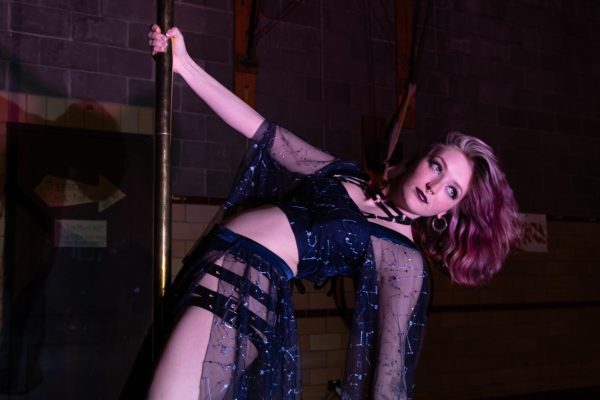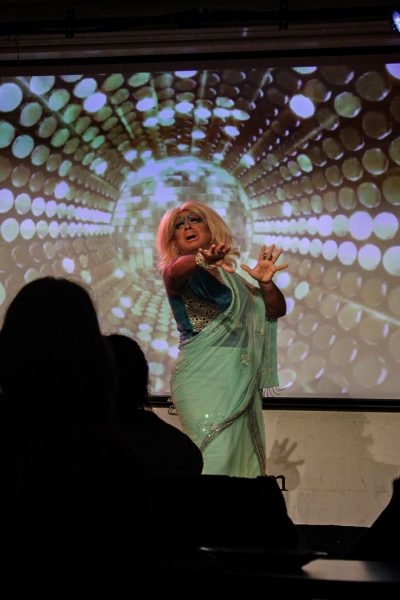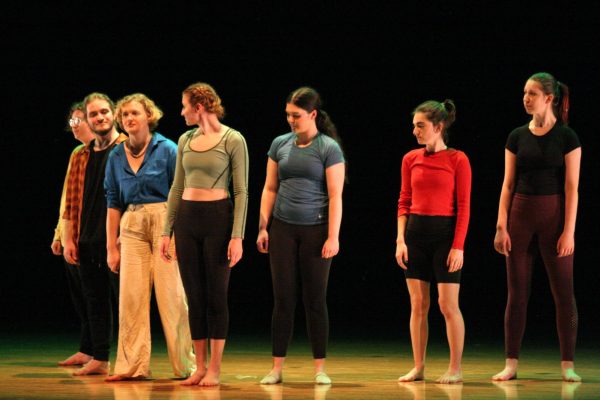Varsity Contact Class Highlights Improv Dance in “One Breath”
Amidst Monday’s rehearsal for Oberlin Dance Company’s upcoming show, College sophomore Georgie Johnson ran up to College junior Gabrielle Ment. Both made a show of a common exercise for starting out lifts in contact improvisation — breathing the arms up and then sweeping them down for momentum — before Johnson launched onto Ment’s shoulders and spiraled in the air, lifted by her partner, spreading her limbs wide and grinning even wider. They spun like a human top.
Smiles like that are one striking aspect of the Varsity Contact class performance in “One Breath: An Evening of Stillness and Motion.” It makes sense that this would punctuate the practice — contact is wordless, while also completely improvised, and serendipitous moments of connection elicit reactions at once joyful, tender, and humorous.
“A lot of times people think improvisation is the absence of technique or structure, just a free-for-all kind of thing,” said Ann Cooper Albright, chair of the Dance department and director of “One Breath.” “That’s not at all the way I look at improvisation. I look at improvisation as a structure of skills that look different than the skills we normally are used to seeing. They’re skills of coordination, of kinesthetic dynamics that are shared among people. … Rather than thinking about the form of the body, we’re really working with … the way in which the whole group moves with different kinds of forces.”
The upcoming performance is heavily centered around the connection of the group and the partnerships and small group dances that make up the typical framework for contact improvisation.
It’s been important for them to remember to “flow with the energy of the group,” College first-year and dancer Kate Trapnell wrote in an email to the Review.
Breath is a key part of this — and it is everywhere in the installation-like performance space, including in the sweeping rolls of paper spread throughout Warner Main Space. These were created by set designers Laura Carlson-Tarantowski and Joanne Steggall in the style of the artist Theresa Antonellis. Antonellis herself will be in-house for the performances, painting live in the style of her series “one breath/one line.” She places her paintbrush on an inhale, and then pulls a line down on the exhale. The paintings are a documentation of breathing — Carlson-Tarantowski and Steggall entered the space for the first time after their creations had been hung and joked, “Look! That’s our breath up there!” Cooper Albright recalled.
To create the performance’s structure, the dancers and Cooper Albright also worked in collaboration with lighting designer Anton Crooks.
“If you’re going to dance for 50 minutes with 11 other people, you need to have some other things going on,” Cooper Albright said.
The dancers not only needed real structure to their movement, but also trust in the integrity of the movement and where it wanted to go in a given moment.
“Once you know how to do the shoulder lifts, [you have] to make sure that you’re not just doing that habitual stuff — that you’re really investigating a situation that allows you to move beyond that,” Cooper Albright said. “There may be some of that there, but it’s coming out of a different impulse than just wanting to show off your tricks.”
The performances are also kept honest and new for the dancers by rotating the placement of cast members.
“There are always possibilities for surprises as we perform,” College junior and dancer Elana Rosenberg wrote in an email to the Review.
In just one rehearsal, there was an unexpected foot-five as two dancers spiraled past one another in a trio, laughter after an assisted headstand, and an unexpected face-plant from which dancers quickly recovered. There are also moments of slowness and sweetness — dancers often clasp hands or nuzzle into one another as they parse out ways to move with their weight and breath shared. It is all in line with Cooper Albright’s motto: “Replace ambition with curiosity.” The beautiful and remarkable aspects of the performance come from the dancers’ willingness to be vulnerable, listen, and never expect any one improvisation to be like another.
A lot of this vulnerability comes from the teachings of acclaimed modern dancer Mary Starks Whitehouse’s technique of “authentic movement.” In “authentic movement,” one dancer in a partnership closes their eyes and, watched by the other, does not move until they feel compelled to do so. Cooper Albright likes to call this “witnessing,” and it is an environment they have strived to create between the audience and the performers for this show — “a supportive gaze rather than a critical gaze.”
At the beginning, the audience members will be allowed to walk around the space, getting a closer look at the dancers and artwork. From there, they can watch the show lengthwise from either side — an intimate experience of closeness to the dancers in the expanse of the historic space.
“Contact has the power to bring the audience into our awareness of tactile sensation, such that it becomes part of their perception of the performance, rather than their perception being limited to visual form,” Cooper Albright said. “They start to see past our bodies into our experience.”
“One Breath” will be performed in Warner Main Space Friday May 4 and Saturday May 5 at 8 p.m., and Sunday May 6 at 3 p.m. for the all-ages performance. Tickets are $5 and are on sale in Hall Lobby or through Central Ticket Services.










